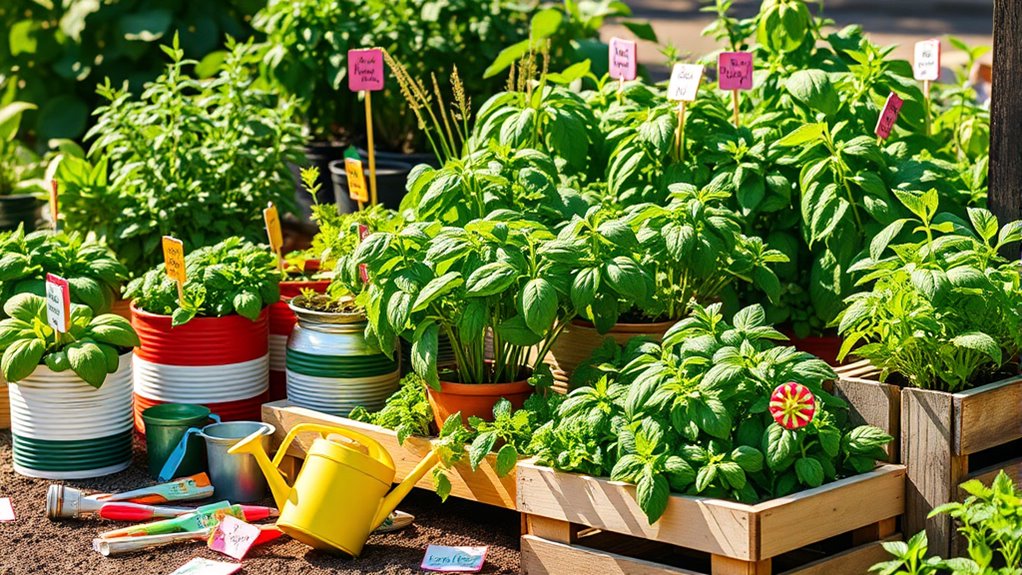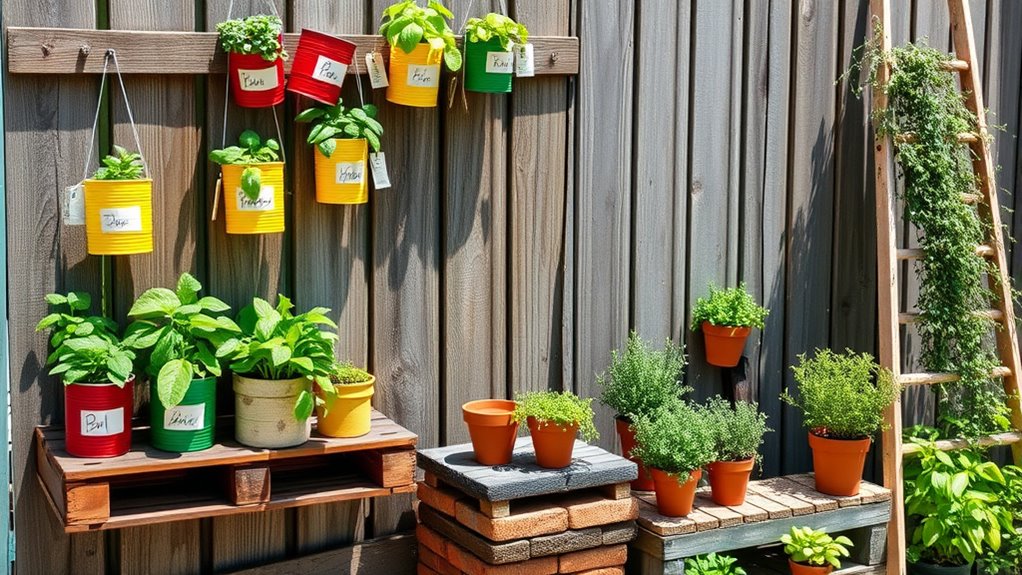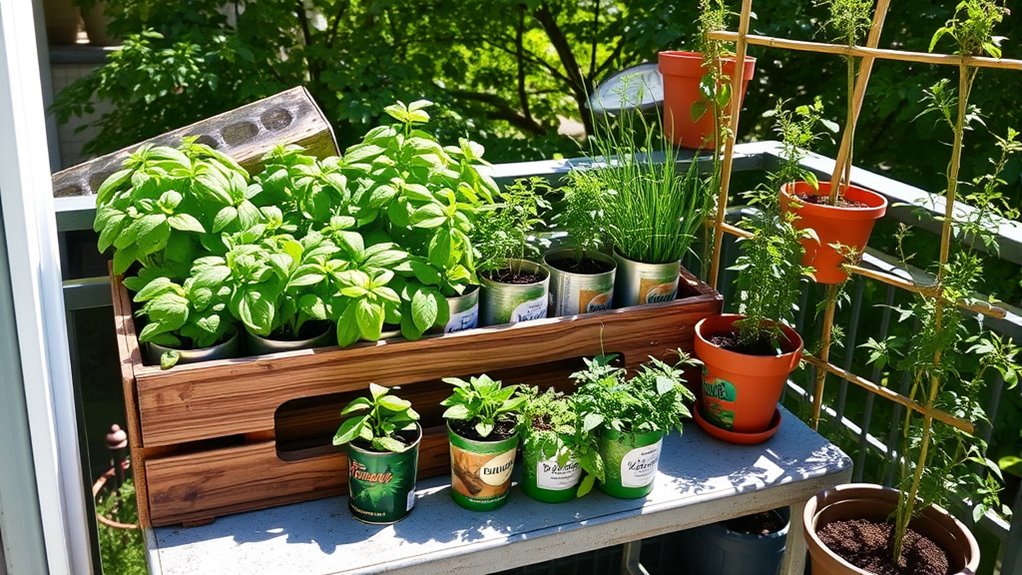To improve your herb garden on a budget, choose affordable, easy-to-grow herbs like basil, parsley, or mint that thrive with minimal care. Use DIY and upcycled containers to save money and maximize space through vertical gardening or stacking. Practice natural pest control with companion planting and composting kitchen scraps for free nutrients. With some simple organization and creative solutions, you’ll boost your garden’s productivity without overspending—continue to explore more budget-friendly tips and tricks for a thriving herb garden.
Key Takeaways
- Use recycled containers and DIY compost to cut costs and enrich soil naturally.
- Prioritize easy-to-grow, low-maintenance herbs like basil, parsley, and mint for reliable yields.
- Implement vertical gardening with repurposed materials to maximize limited space efficiently.
- Practice companion planting to naturally deter pests and reduce the need for chemical treatments.
- Opt for affordable, multi-purpose herbs like thyme and dill to serve culinary and pest control roles.
Choosing Cost-Effective Herbs and Supplies

When selecting herbs and supplies for your garden, focusing on cost-effective options can help you save money without sacrificing quality. Opt for popular, easy-to-grow herbs like basil, parsley, and mint, which often come at affordable prices and thrive with minimal care. Incorporate companion planting strategies to naturally enhance pest control—planting basil near tomatoes can deter pests, reducing the need for chemical treatments. Choose affordable supplies such as recycled containers, DIY compost, and seed-starting trays made from upcycled materials. These options not only save money but also promote sustainable gardening. Prioritize herbs that offer multiple benefits, like thyme or dill, which can be used in cooking and for pest deterrence. Additionally, understanding projector contrast ratio can help you select the right equipment for a better viewing experience, especially if you plan to create a cozy outdoor or indoor garden space with visual displays. This approach ensures a thriving herb garden without breaking your budget.
Maximizing Space With DIY and Upcycled Solutions

Maximizing space in your herb garden doesn’t require a large yard or expensive equipment. You can use vertical gardening to make the most of limited space by stacking containers or mounting planters on walls. DIY vertical gardens, like repurposed pallets or hanging shoe organizers, offer affordable options that turn vertical surfaces into thriving herb beds. Container stacking is another smart solution; by placing pots of different sizes on top of each other, you create multiple planting levels in a small footprint. These upcycled solutions help you grow a variety of herbs without spreading out horizontally. Incorporating space-saving techniques can further enhance your garden’s productivity and organization. With some creativity and basic tools, you can transform tight spaces into productive, lush herb gardens while keeping costs low.
Maintaining Your Herb Garden on a Budget

Maintaining your herb garden on a budget is entirely possible with some simple strategies. One effective method is companion planting, which naturally repels pests and reduces the need for chemical pest control. For example, planting basil near tomatoes can deter pests and improve growth. Regularly inspect your herbs and remove any pests by hand to avoid expensive treatments. Composting kitchen scraps provides free, nutritious soil amendments that keep your plants healthy. Water early in the morning to minimize evaporation and save on water bills. Use organic solutions like neem oil if pest issues arise, which is more affordable than commercial pesticides. Additionally, choosing aesthetic wall organization solutions can help you create a functional and visually appealing space for your herbs without spending much. By practicing these cost-effective techniques, you’ll keep your herb garden thriving without overspending.
Frequently Asked Questions
How Can I Start an Herb Garden Indoors Cheaply?
You can start an herb garden indoors cheaply by using natural light from your windows and supplementing with affordable grow lights if needed. Choose budget-friendly soil with good drainage, like potting mix, and avoid expensive fertilizers. Repurpose containers such as jars or old pots, ensuring proper drainage. Regular watering and monitoring indoor lighting will help your herbs thrive without breaking the bank.
Are There Seasonal Herbs That Save Money?
Think of seasonal herb varieties as nature’s sale signs—offering fresh flavors without draining your wallet. By choosing cost-effective herb choices like basil in summer or thyme in winter, you save money while enjoying garden bounty year-round. These seasonal herbs thrive at different times, so you can plan your planting schedule around their peak, making your herb garden both vibrant and budget-friendly. It’s a smart way to keep green thumbs happy and costs low.
What Are the Best Free Resources for Herb Gardening Tips?
You can find great free resources for herb gardening tips online, like gardening blogs and forums. Focus on guides that cover companion planting to maximize space and improve growth, and don’t forget to test your soil for nutrients. Many local extension offices also provide free soil testing kits and advice. These resources help you plan efficiently, saving money while ensuring your herbs thrive.
How Do I Prevent Pests Without Spending Extra?
You can prevent pests without extra costs by practicing companion planting, which naturally deters insects, and using natural repellents like neem oil or garlic spray. Plant herbs like basil near others to repel pests, and encourage beneficial insects that prey on garden pests. Regularly inspect your herbs for signs of pests, and manually remove any invaders. These methods are eco-friendly, effective, and won’t strain your budget.
Can I Propagate Herbs From Kitchen Scraps?
Imagine turning kitchen scraps into a lush herb garden, like magic slowly happening on your windowsill. Yes, you can propagate herbs from kitchen scraps—just snip a healthy stem, place it in water, and watch roots form. Use composting tips to enrich your soil and herb storage solutions to keep your herbs fresh. This simple, cost-effective approach transforms leftovers into vibrant, living herbs, giving new life to your kitchen and garden alike.
Conclusion
With a little creativity and resourcefulness, you can turn your herb garden into a lush, fragrant haven without breaking the bank. Think of your budget-friendly efforts as planting seeds of joy that grow into a thriving oasis right outside your door. By choosing smart supplies, upcycling materials, and staying attentive, you’ll nurture a garden that’s both beautiful and budget-conscious. Your herbs will flourish, and so will your sense of accomplishment—proving that a little ingenuity goes a long way.










